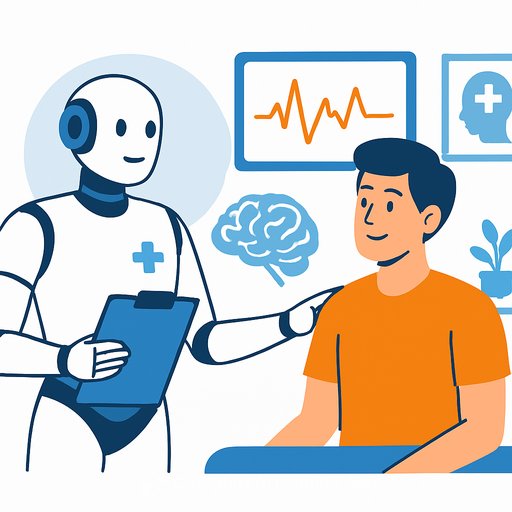China's National AI Healthcare Strategy: Faster, more consistent diagnosis by 2030
Walk into a clinic, get a clear diagnosis in minutes. That's the standard China is targeting with its National AI Healthcare Strategy, announced by the National Health Commission on November 4, 2025. The plan sets a firm path: high-quality health datasets and AI diagnostic tools nationwide by 2027, and AI-assisted diagnosis available across primary care by 2030-reaching more than 900 million citizens.
The initiative brings together large language models (LLMs), medical imaging analysis, smart nursing devices, and unified data systems to raise diagnostic accuracy and shrink wait times across the care continuum.
Where AI fits in care delivery
- Primary care: symptom assessment, triage, differential support, and referral guidance.
- Imaging: automated reads and prioritization for radiology and ultrasound queues.
- Specialist support: clinical decision support for complex cases and rare presentations.
- Patient services: AI-enabled consultation support and education at the point of care.
How it works
A centralized national health information platform will connect federal, provincial, city, and county facilities into an integrated medical data center. AI models will analyze structured and unstructured inputs-EHR entries, labs, imaging, vitals, and patient-reported data-to provide diagnostic recommendations and decision support inside routine workflows.
Hospitals and clinics will feed and retrieve insights through shared services, enabling consistent protocols and faster handoffs between primary care and specialty teams.
Early results from pilots
- Diagnostic accuracy improved from 85-90% to over 95% in reported pilots.
- Time-to-diagnosis fell from 1-2 days to minutes for common conditions.
Closing the rural-urban care gap
China's system faces uneven access: fewer diagnostic specialists in rural clinics, higher concentrations in major cities, and misdiagnosis rates reported up to 50% in some primary care settings. Universal AI assistance aims to close that gap with consistent, high-quality support at the first touchpoint.
- Rural focus: Of 900+ million citizens in scope, 600+ million rural residents stand to gain from localized diagnostic capabilities.
- Beneficiaries: Medical staff in resource-constrained areas, specialty hospitals, and an estimated 25,000+ township and village clinics.
- Long-term impact: With earlier detection and prevention, per-capita healthcare spending could drop by as much as 20% by 2030.
Rollout and funding
- Nov 2025-Mar 2026: Infrastructure planning.
- Apr-Dec 2026: Pilots in 50 hospitals and 500 township clinics.
- By end of 2027: National health database integration and high-quality datasets completed; AI tools available nationwide.
- By 2030: Universal primary care adoption; all Grade 2+ hospitals fully integrated.
Budget: CNY 15-20 billion (USD $2-3 billion) over five years.
KPIs to watch
- Reduce primary care misdiagnosis from 40-50% to 15-20%.
- Achieve over 95% diagnostic accuracy for AI-assisted imaging.
- Ensure every Grade 2+ hospital uses AI medical imaging by decade's end.
What this means for healthcare leaders and clinicians
This is as much an operational program as it is a technical one. The gains show up only if data, workflows, and governance are ready.
- Data readiness: Standardize coding (ICD-10/11, SNOMED CT), adoption of HL7 FHIR, clean data pipelines, de-identification, and clear consent models.
- Workflow redesign: Embed AI outputs at decision points-triage, imaging reads, and discharge planning-plus escalation rules for specialist review.
- Clinical governance: Local validation against gold standards, bias monitoring across demographics, peer review for edge cases, and audit trails for every AI-influenced decision.
- Skills and training: Baseline AI literacy for clinicians, super-user tracks for informatics leads, and ongoing refreshers tied to model updates. For structured upskilling, see curated options by role at Complete AI Training.
- Integration: Tight connections with EHR, PACS/VNA, LIS, and bedside devices. Optimize routing so AI results land in the clinician's primary view-not a separate portal.
- Infrastructure: Edge inference for low-bandwidth sites, resilient offline modes for rural clinics, and centralized model management for updates.
- Cybersecurity: Role-based access, least-privilege data flows, incident response plans, and model integrity checks.
- Patient communication: Clear explanations of AI involvement, consent where applicable, and simple summaries patients can understand.
- Metrics: Track sensitivity/specificity, PPV/NPV, turnaround time, escalation rates, readmissions, and patient-reported outcomes. Set baselines before deployment.
Risk and safety guardrails
- Bias and equity: Continually test across age, sex, ethnicity, and comorbidities. Retrain on underrepresented groups.
- Overreliance: Keep clinician-in-the-loop with final accountability. Use decision support, not decision replacement, for high-stakes calls.
- Liability: Define boundaries for vendor vs. provider responsibility, and document how recommendations are accepted or overridden.
- Procurement transparency: Demand model lineage, intended use, contraindications, dataset statements, and performance by subgroup.
- Post-market surveillance: Continuous monitoring, drift detection, and rapid rollback channels for underperforming models.
Useful references
- WHO guidance on ethics and governance of AI for health
- National Health Commission of the People's Republic of China
The bottom line
Compressing diagnosis from days to minutes, with consistent quality across regions, changes patient flow and outcomes. The technology is here; the real work is data quality, workflow design, staff training, and rigorous oversight.
Start with pilots, measure relentlessly, and scale what proves safe and effective. That's how this strategy delivers value across clinics and hospitals-urban and rural alike.
Your membership also unlocks:






